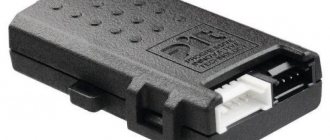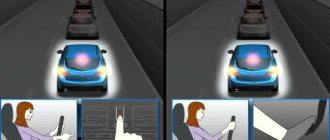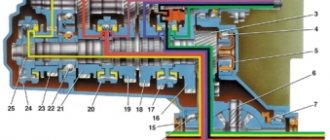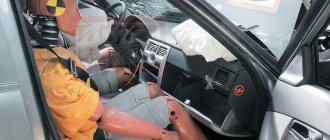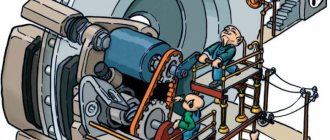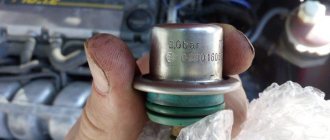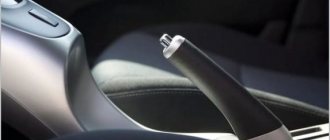Airbag (airbag) is one of the passive safety elements in modern cars. Their presence is an important factor ensuring the safety of the driver and passengers. Airbag translated from English means “air cushion”, hence the Russian name – airbag, which we are all accustomed to using.
Airbags have saved thousands of lives since they were widely installed on vehicles. The idea behind the Airbag system is simple: airbags inflate quickly enough to protect the human body in the event of an accident. But how do they do it so quickly?
A little history
Photo: caradvice.com.au
The birthplace of airbags, as you might guess, is the USA. Back in the early 50s, engineers John Hendrick and Walter Linderer patented an inflatable bag that was triggered in the event of an accident. True, for quite a long time designers puzzled over a sensor that could send a signal in the event of a collision. The solution was found in 1967, when inventor Allen Breed proposed a ball sensor that responded to a very sudden change in speed that could only occur during an impact. Breed sold the technology to Chrysler, but the concern's worst competitors became pioneers in the mass production of cars with pillows.
However, this will happen only four years later. And while automakers were busy implementing the technology, congressmen entered the arena. The plans were ambitious: wanting to show voters that they cared about their lives, deputies passed a law obliging all production cars to be equipped with airbags by 1973. The idea was openly populist, but under pressure from the authorities, car companies were forced to speed up development.
One after another in 1971, the Ford Taunus P7 and Oldsmoblie Toronado were released, equipped as an option with inflatable bags for the driver and passenger. True, back then the airbags were positioned as an alternative to seat belts, and it soon became clear that the idea was a failure. Americans were afraid of pillows and did not want to overpay for them. Several deaths added fuel to the fire - drivers died of heart attacks, shocked by the loud pop with which the airbags inflated.
Looking ahead, it is worth mentioning that airbags on American cars only became mandatory in 1998. And in 1981, the first European car with inflatable bags appeared.
It was the Mercedes-Benz S-class in the then-new W126 body, which allowed it to be named the safest car in the world for two years in a row (in 1988 and 1989) according to the American Institute for the Study of Highway Mortality.
In the 90s, when tests proved the effectiveness of airbags, they began to be used everywhere. In Russia they are still not mandatory, perhaps also because it is simply not cost-effective to install them on a number of archaic models. The VAZ “classics” and “Samara” are history.
The last of the Mohicans remains the Lada 4x4, better known as the Niva - you cannot install airbags on it at any cost. But Granta, Kalina, Priora and Largus have them in their “base”, which gives us hope for a bright future.
Operating principle
In general terms, the principle of operation of an airbag is as follows: after a car is hit, the sensors located in the car are activated. Once they fire and send a signal to the airbag control device, the latter determines how many and which airbags need to be activated. Then, a signal is given and the squib located in the airbag is triggered, inflating the pillow.
Now in more detail. If a car gets into an accident, as a result of the impact the car acquires uncharacteristic acceleration and also receives damage. A sudden change in speed as a result of an impact is a condition for the airbags to deploy. These changes are instantly recorded by the corresponding sensors. The sensors transmit information to the control module, from where the signal goes to specific airbag modules.
When a signal to deploy is received, the squib in the airbag module detonates. The resulting volume of gas inflates the airbag in a matter of seconds.
How long does it take? Typically, the response time is about 15-25 milliseconds. This short period of time is due to the need to inflate the pillow before it makes contact with the body. Otherwise, the blow to the pillow will not only not soften, but can cause serious injury, and even death. Such cases occurred in the early stages of the development of airbags. Modern airbags are free of these shortcomings. In addition to instant opening, they also have such a structural feature as gas outlets. This means that the airbag begins to deflate almost immediately after deployment, thereby compensating for excessive pressure on the victim’s body, preventing him from suffocating (in the case of frontal airbags).
How are modern pillows arranged?
There is nothing particularly clever in the design of the pillow itself - it is a bag made of thin fabric (usually nylon). Often these bags have several chambers. For example, the passenger front is divided into a larger lower section for the body and a smaller one for the head. The bag is placed in a compact capsule and sprinkled with talcum powder or starch to prevent caking. It is this powder that sometimes flies in the air after the system is activated.
Photo: verkehr.fraunhofer.de
Initially, it was clear that the airbags had to be inflated very quickly - in 20-50 milliseconds. Since the 70s of the last century, the only possible means for this has been a small explosion, which results in the release of gas that fills the space inside the bag. The explosion is provided by a squib, which detonates a piece of fuel made from sodium azide (not to be confused with oxide!), potassium nitrate and silicon dioxide. The explosion produces harmless, non-toxic nitrogen. There are also hybrid filling units, in which the charge of solid fuel is just a “plug” plugging a cylinder with compressed nitrogen. The force of the explosion is lower, and the noise is also less.
In modern cars, the command to fire the airbags is given by an electronic control unit, which collects information from impact sensors. There are a lot of sensors, and the computer can distinguish in which direction the blow fell. Therefore, if the car is hit on the side, the front airbags will not work. More advanced systems also take into account the force of the impact and even the weight of the passenger, adjusting the amount of gas entering the airbag and, accordingly, its size.
How does an airbag work?
When the vehicle collides with an object:
- The sensor detects the impact and transmits data to the system ECU: this takes 3 milliseconds.
- The electronic unit sends a command to the gas generator.
- The detonator goes off. The charge from the sodium acid tablets explodes, forming argon or ozone.
- This gas passes through a filter, where it partially loses its temperature, and enters the pillow under a pressure of up to 250 mPa.
- The BB, having broken the protective pad, fires within 30-50 milliseconds from the moment the sensor detects the collision.
- A person hits a soft buffer, which absorbs 90% of the impact energy.
The “bell” falls, releasing harmless gas through special holes.
At what speed
The threshold vehicle speed at which the air bags are activated is 22 km/h. But speed is not the main indicator for activating the system, because a car can be crashed into while parked. Therefore, the sensors take into account, first of all, the force and direction of the impact.
How they work during an accident
A collision with a stationary object can only be frontal. But with another car - front, tangentially or end. However, a significant blow can also be received from behind.
Cars turn over, somersault: at this moment the prerequisites are created for the deployment of one or more types of pillows. The front “bells”, having accepted the person’s head, are deflated immediately, the side ones hold the pressure for 7 seconds in case the car rolls over several times.
Airbags are useless and even dangerous if you are not wearing a seat belt: the speed of the airbag during departure is 200-300 m/sec. The human reaction to an accident is lower, so people do not have time to get scared and understand what happened.
Where are the airbags located?
Traditionally, frontal airbags are located in the steering wheel housing for the driver and in the dashboard for the passenger. Side airbags can be placed in different places: in or above the doors, in pillars or seat backs. Often there are combined solutions: for example, a curtain shoots out from a slot above the door to protect the head, and a second lower pillow shoots out from the chair to protect the chest, abdomen and pelvis.
The legs are protected from contact with the hard plastic of the dashboard by a knee pad, which is “wired” under the steering wheel. In 2009, Toyota also introduced central airbags - they are located in the seat back or in the armrest and prevent injuries that the driver and passenger can inflict on each other in a side impact.
Photo: autoblog.com
Emerging problems
Front airbags are designed to protect people from adults. Since children are smaller, they are at risk of injury from its operation. Therefore, they should not occupy the front seat if the car has an Airbag for the passenger. The car should not have accessories installed that could limit the deployment of the Airbag or become a missile when it is deployed. Airbag systems usually have a warning light with an indicator. If the lamp does not go out immediately after starting or comes on while driving, check the owner's manual and have it checked by a workshop. The system has detected an error.
If you don't do this, the airbags may unexpectedly deploy during repairs, especially during electrical work. This can cause serious injury, so leave repairs to qualified personnel. The airbags deploy with explosive force and are far from the big fluffy airbags some people might imagine. It is not uncommon for minor injuries and abrasions to remain from contact with the pillow. Several vehicle manufacturers determine the lifespan of airbag components. Usually the airbag warning light comes on and components must be replaced before it goes off.
For motorcyclists and cyclists
In 2006, the first motorcycle with an airbag debuted, the big Honda Goldwing chopper. The pillow is built into its front panel and is generally similar to a car one. So far, the technology has not been widely used by competitors.
Motorcyclists, especially extreme riders, prefer… suits with pillows to “automotive” solutions. The capsule with it is located on the neck; when it falls, it opens like a collar, and instead of hard asphalt, the biker hits his head on soft fabric.
Inflation system
In another way it is called a gas generator. Its essence is to fill the shell of the protective device with gas. It includes a squib, which, in fact, starts the mechanism. Here the interesting question is how does the airbag impact sensor work?
In essence, here the contacts of the device close under certain circumstances, which leads to the activation of the actuators. They, in turn, fill the pillows with gas.
Initially, the system included only this one element, but in modern “airbags” there are already 2 of them. The first is considered the main one and ensures the release of 80% of the gas. The second is a squib, which is connected in the event of a strong collision, when a person needs a harder cushion.
All these components must be in good condition to ensure trouble-free operation of the system.
And for pedestrians too
If you have a particularly tender love for pedestrians, then your car is the Volvo V40 Cross Country. This is the only car on the Russian market (and also the first production car in the world) that is equipped with an airbag for pedestrians. It is located under the hood and shoots, lifting it and covering almost the entire windshield. Unfortunately, this device does not protect you from broken legs (the edge of the hood and the bumper remain rigid), but it does protect you from a traumatic brain injury.
But how does the V40 understand that a collision occurred with a pedestrian, and not, say, with a pole? A thermal imager is responsible for this, which measures the temperature of the object the car is approaching from a distance. In addition to the unique airbag, Volvo also has a City Safety system with forced emergency braking. So, ideally, a pedestrian should not need a pillow at all.
Some statistics
Research activity regarding the effectiveness of airbags peaked in the early 2000s. Pillows have been widely adopted since the early 90s, and a decade later, researchers have a basis to study.
In 2001, the US Highway Safety Administration (NHTSA) concluded that airbags saved more than 8,000 lives in the first decade. In 2009, NHTSA calculated that when seat belts are worn, frontal airbags reduce the risk of death by 11%.
Photo: emercedesbenz.com
In 2003, doctors Eliza Braver and Sergei Kirichenko studied accident data in the United States in 1999-2001, and came to the quite expected conclusion that the presence of side airbags in a car significantly reduces the risk of death in a side collision. Statistics were collected exclusively on then-modern cars of the 1997-2002 model years.
And now the specifics: over two years, 1,800 people died in side collisions in cars without side airbags at all, 105 people died in cars equipped only with torso airbags, and only 35 people died in vehicles with inflatable curtains to protect the head. It turns out that the presence of side airbags reduces the risk of death in an accident by one or two orders of magnitude. A good reason to think about the configuration of your car.
Photo: emercedesbenz.com
It is worth noting that any statistical analysis is something conditional. It is always difficult to identify the exact cause of a person’s death in an accident, and even more so to understand why the person who survived the accident did not die. In this case, full-scale tests of cars with airbags, that is, crash tests, are very useful.
This SRS section contains important information about the driver and front passenger airbags, side airbags, and curtain airbags.
Airbags complement seat belts, which are the main element of the protection system. They protect the head and chest of the driver and front passenger in moderate to severe frontal collisions. The car is equipped with driver and front passenger airbags that deploy in two stages. The degree to which the airbags deploy depends on the force of the impact, which is determined by sensors located in the front and lower middle parts of the vehicle.
Side airbags (if equipped) are a supplement to seat belts to help protect the driver and front passenger from chest and abdominal injuries in certain types of moderate to severe side impacts.
Curtain airbags (if equipped) are a supplement to seat belts that help protect occupants from head injury in some types of moderate to severe side crashes.
Airbags are NOT a replacement for seat belts. To ensure maximum protection for people in any traffic accident, all passengers in the vehicle must wear seat belts.
Supplemental Restraint System (SRS) Operation
The Supplemental Restraint System (SRS) includes the following elements:
- Driver airbag module
- Front passenger airbag deactivation warning lamp
- Front passenger airbag module
- Front passenger airbag switch
- Side airbag modules
- Curtain airbag modules
The airbags only deploy when the ignition key is in the ON or START position.
When the airbags inflate, there is a sharp, loud sound and some smoke and dust are released, but this is harmless and will not cause the vehicle to catch fire. People with respiratory problems may experience temporary irritation from the chemicals used to fill the pillows; After the gas has been released from the airbags, open the window if it is safe to do so. After deployment, the airbags deflate very quickly, so there is little risk of obstruction of vision.
Warning
The airbags fill extremely quickly. In some cases, contact with the expansion cushion may result in minor cuts, bruises, etc.
Warning
IT IS VERY IMPORTANT TO BE IN THE CORRECT POSITION ON THE SEAT. A driver or front passenger who is too close to the steering wheel or dashboard when the airbags deploy could be killed or seriously injured. The airbags inflate very quickly and with great force. If the driver or front passenger is seated incorrectly or is not wearing their seat belt correctly, the air bags may not only fail to protect them, but may cause serious or fatal injury if deployed.
Warning
- Do not sit on the edge of the seat or place your head or chest close to the steering wheel or instrument panel. Do not place your feet on the dashboard.
- Place infants and young children in the rear seat in an appropriate child safety seat. The back seat is the safest place for infants and young children.
Warning
Do not transport young children unrestrained, allow them to stand against the dashboard, or hold them on your hands or knees.
They can be seriously injured or killed in a collision, including if the airbags deploy. They must be correctly placed in the rear seat of the vehicle in appropriate child seats. See the Child Seats section of this manual. Rear-facing child seats must be placed in the rear seats, or (if installed in the front seat) the front passenger airbag must be deactivated. See section "Disable the Airbag".
Warning
- A REAR-FORTH-FRONT CHILD SEAT MUST NOT be installed in the front passenger seat unless the front passenger airbag is deactivated. An airbag that inflates with great force can kill or seriously injure a child. Rear-facing child seats must be installed in the rear seat of the vehicle.
- REAR-FACING CHILD SEATS are recommended to be placed in the rear seat of the vehicle; When installing them on the front passenger seat, move the front seat all the way back. Failure to do so could result in death or serious injury to the child.
Warning
Older children should ride in the back seat of the car and wear a seat belt, and if necessary use a suitable child seat.
Caution against installing child seats on vehicles with a front passenger airbag
The label shown in the illustration applies to vehicles equipped with a front passenger airbag.
Warning
Extremely dangerous! Do not install rear-facing child seats on vehicle seats that have airbags in front of them!
Front passenger airbag switch
This switch is used to disable the front passenger airbag. If you purchased a rear-facing child seat that cannot be secured in any seat other than the front passenger seat, be sure to disable the airbag before installing it. See section "Disable the airbag". The airbag switch is located in the glove compartment.
Front passenger airbag deactivation warning lamp
The front passenger airbag deactivation indicator light is located on the instrument panel.
The warning lamp should light up when the ignition is turned ON and go out after a few seconds. When the front passenger airbag switch is set to OFF, the warning lamp will illuminate to indicate that the airbag is disabled. When the front passenger airbag switch is set to ON, the warning lamp will go off; this indicates that the airbag is turned on.
Warning
Do not install any accessories on your vehicle that could obscure the airbag deactivation warning light, and do not cover the warning light with stickers. In this case, you will not be able to control whether the airbag turns on or off.
Airbag deactivation
Warning
- To reduce the risk of serious or fatal injury:
- Before turning the airbag switch, be sure to remove the key from the ignition. Failure to do so may result in accidental deployment of the airbag.
- After turning the ignition key from ON to LOCK (after turning off the ignition), wait approximately 60 seconds before operating the airbag switch. The airbag system is designed to maintain sufficient voltage to inflate the airbags for a period of time.
- After turning off the airbag, be sure to remove the key from the switch. Failure to do so may accidentally set the switch to the wrong position.
- Disable the front passenger airbag only before installing a forward-facing child seat in the front seat and do not disable it at any other time.
- If the warning light does not come on after turning off the airbag using the switch on the instrument panel, do not install a forward-facing child seat in the front passenger seat. It is recommended that you contact an authorized Mitsubishi Motors service center to check the system.
- If the airbag deactivation indicator remains illuminated after turning the airbag on using the switch, do not allow anyone to sit in the front passenger seat. It is recommended that you contact an authorized Mitsubishi Motors service center to check the system.
To disable the airbag, do the following:
- Insert the key into the airbag switch and turn it to the OFF position.
- Remove the key from the airbag switch.
- Insert the key into the ignition and turn it to the ON position. The airbag deactivation indicator light should come on and not go out. The airbag deactivation indicator light should be on. The front passenger airbag is disabled and will not deploy unless it is enabled.
Driver and passenger front airbag system
The driver's airbag is located under a convex cover in the center of the steering wheel. The front passenger airbag is located in the instrument panel above the glove compartment. The driver and front passenger airbags are designed to inflate simultaneously, even when there is no passenger in the front seat. The driver's airbag inflates in two stages, depending on the severity of the impact. The front passenger's airbag deploys at the same time as the driver's, even if there is no passenger in the seat, and deploys in two stages, depending on the severity of the impact.
Front airbag deployment
The front air bags are rated to deploy in the following situations: The front air bags are rated to deploy in moderate to severe frontal impacts. A typical case is shown in the figure.
- Frontal impact with a stationary obstacle at a speed of approximately 25 km/h or more
- Moderate to severe frontal impact in the shaded area between the arrows
The front airbags are deployed if the impact energy exceeds a certain threshold level, comparable to a collision at a speed of about 25 km/h with a rigid, stationary obstacle that does not deform. If the impact energy is less than the threshold value, the airbags may not deploy. However, the impact velocity threshold will be significantly higher when the vehicle collides with objects that absorb energy through deformation or movement (for example, another stationary vehicle, a post, or a guardrail). Because a frontal impact can cause the driver or passenger to be dislodged from their seats, proper use of seat belts is important. The seat belt will keep the person at a safe distance from the steering wheel and instrument panel when the airbags initially deploy. During the initial deployment phase, the airbag has the most energy and can cause severe or fatal injury. In addition, the seat belt is the main means of protection in a collision. Airbags are designed as an additional means of protection. Therefore, to ensure your own safety and the safety of passengers, it is necessary to use seat belts correctly.
Front airbags MAY NOT INFLATE in the following situations: In some types of frontal impacts, because the vehicle body is able to absorb the impact energy to protect the occupants. (The front of the vehicle may become severely deformed, absorbing the energy of the impact.) In this case, the front air bags may not deploy despite the deformation and damage to the vehicle's body. Some typical cases are shown in the figure.
- Colliding with a pole, tree or other narrow object
- Rolling a car under the back of a truck
- Impact of the front of the car at an angle
Because front airbags do not protect in all frontal collisions, be sure to wear your seat belt.
Front airbags are NOT DESIGNED TO INFLATE in the following situations: Front airbags are not rated to deploy in situations where they cannot protect an occupant. Such cases are shown in the figure.
- Side-by-side collisions (impacts to the rear of the vehicle)
- Side impacts
- Rollover of a vehicle onto its side or onto its roof
Because front airbags do not protect in all collisions, be sure to wear your seat belt.
The front airbags MAY INFLATE in the following situations. The front airbags may deploy in the event of a moderate to severe underbody impact (damage to the underbody and chassis). Some typical cases are shown in the figure.
- Hitting a raised median, traffic island or curb
- The car gets into a deep hole or pothole
- A car slides down a steep slope and hits the ground
Because airbags can inflate under some of the types of sudden impacts shown in the illustration that could cause vehicle occupants to be dislodged from their seats, it is very important to use seat belts correctly. The seat belt will keep the person at a safe distance from the steering wheel and instrument panel when the airbags initially deploy. During the initial deployment phase, the airbag has the most energy and can cause severe or fatal injury upon contact.
Warning
- Do not attach any objects (decorations, stickers, etc.) to the steering wheel convex cover. They can hit and injure the driver when the airbag deploys.
- Do not place or attach any objects to the instrument panel using the glove compartment. They can hit and injure the occupant when the airbag deploys.
- Do not attach any objects to the windshield or place them in front of it. They may prevent the airbags from deploying or strike and injure the occupant when the airbags deploy.
- Do not place bags, animals or any objects between the airbag and the driver or front passenger. They may prevent the airbags from deploying or strike and injure the occupant when the airbags deploy.
- Immediately after the airbags deploy, some parts may be hot. Don't touch them. There is a risk of burns.
- The airbag system is designed to deploy once. Once triggered, they cannot be used again. They need to be replaced as soon as possible, and it is recommended that the entire airbag system be checked by an authorized Mitsubishi Motors service center.
Side airbag system
Side airbags (A) are installed in the backrests of the front seats. Side airbags inflate only in the event of a side impact on the relevant side, even without a front seat occupant.
The labels shown in the illustration are affixed to the backrests of seats in which airbags are installed.
Curtain airbag system
Curtain airbags are located in the A-pillars and side roof frame elements. Curtain airbags inflate only in the event of a side impact on the affected side, even when there is no front or rear seat occupant.
Deployment of side airbags and curtain airbags
Side and curtain airbags are rated to deploy in the following situations: Side and curtain airbags are designed to deploy in the event of a moderate to severe side impact to the center of the passenger compartment. A typical case is shown in the figure. The seat belt is the primary means of protection in a collision. Side airbags and curtain airbags are designed to provide additional protection. Therefore, to ensure your own safety and the safety of passengers, it is necessary to use seat belts correctly.
Side airbags and curtain airbags MAY NOT INFLINE in the following situations. In some types of side impacts, because the vehicle body is able to absorb the energy of the impact, protecting the occupants. (The side of the vehicle may become severely deformed, absorbing the force of the impact.) In this case, the side airbags and curtain airbags may not deploy despite the deformation and damage to the vehicle's body. Additionally, depending on the location of the impact, the side airbags and curtain airbags may not inflate at the same time. Some typical cases are shown in the figure.
- Side impacts to areas outside the passenger compartment
- Impacts to the side of the car from a motorcycle or other similar small vehicle
- Lateral collisions with a pole, tree or other narrow object
- Sliding side impacts
- Rollover of a vehicle onto its side or onto its roof
Because side and curtain airbags do not provide protection in all side impacts, be sure to wear a seat belt.
Side and curtain airbags are NOT DESIGNED TO INFLATE in the following situations. Side and curtain airbags are not designed to deploy in situations where they cannot protect an occupant. Such cases are shown in the figure.
- Head-on collisions
- Side-by-side collisions (impacts to the rear of the vehicle)
Because side and curtain airbags do not provide protection in all collisions, you should always wear a seat belt.
Warning
- Side and curtain airbags are a supplement to seat belts that protect the driver and passenger in certain types of side impacts. When properly wearing seat belts, the driver and passengers should sit upright, leaning back in their seats, not leaning against the glass or door.
- Side airbags and curtain airbags inflate with great force. The driver and passengers are advised not to reach out of windows or lean against doors to avoid serious or fatal injury when the side airbags and curtain airbags deploy.
- Do not allow rear passengers to lean on the front seatbacks, otherwise they may be injured if the side airbags deploy. Particular attention must be paid to children.
- Do not place any objects near or in front of the front seat backrests. When deployed, the side airbag may strike and throw them, causing injury to occupants. They may also prevent the airbags from deploying.
- It is prohibited to stick labels or other objects onto the backs of the front seats. They may prevent the side airbags from deploying.
- Do not place covers or covers on seats with side airbags. Do not place covers on the backrests of seats with side airbags. They may prevent the side airbags from deploying.
- Do not install a microphone (A) or other devices in the deployment areas of curtain airbags (B): the windshield, door windows, A-pillars, C-pillars, roof sides, and auxiliary handles. When the curtain airbags deploy, the microphone or other objects may be thrown with great force or interfere with the deployment of the airbags, which could result in death or serious injury.
- Do not hang hangers, heavy or sharp objects on coat hooks. When the curtain airbags deploy, these objects will be thrown with great force and prevent the airbags from deploying properly. Hang clothes directly on the hook (without a hanger). Make sure that there are no heavy or sharp objects in the pockets of clothes that are hung on a hook.
- Do not install a rear-facing child seat on the front passenger seat. If possible, rear-facing child seats should also be installed in the rear seat. If a rear-facing child seat is required in the front seat of the vehicle, move the front seat all the way back and ensure that the child remains in the child seat and does not touch the door.
- Do not allow children to lean against or lean close to the front door, even if the child is in a child seat. Also, do not allow children to tilt their heads into the deployment area of the side airbags or curtain airbags. A child may be injured if the side airbags or curtain airbags deploy. Failure to follow these rules may result in serious injury or death to the child.
- It is recommended that any work on parts located near the side airbags and curtain airbags be performed by an authorized Mitsubishi Motors service center.
Safety System (SRS) Warning Lamp/Display
The safety system warning lamp/display turns on when a malfunction occurs in the system. The message “SERVICE REQUIRED” will appear on the multifunction display. When you turn the ignition ON, the warning light should come on for a few seconds and then go off. If there is a malfunction in the safety restraint system (SRS) or seat belt pretensioners, the warning light comes on and stays on without blinking. The airbag and seat belt pretensioner faults are indicated by the same safety system (SRS) warning lamp.
Warning
- If any of the following symptoms are present, the safety system (SRS) is not working properly. In this case, it is recommended to have it checked as soon as possible at an authorized Mitsubishi Motors service center.
- The SRS warning light does not light up when the engine starts.
- The SRS warning light comes on while the vehicle is moving.
- A warning appears on the display while the vehicle is moving.
Safety System (SRS) Maintenance
Warning
- It is recommended that all maintenance work on the SRS system and components located next to it be carried out at an authorized Mitsubishi Motors service center. Incorrectly performed work on the components and parts of the SRS system and electrical wiring can lead to unexpected deployment of airbags or failure of the system; any of these cases could result in serious injury.
- Do not modify the steering wheel, seat belt pretensioners or other SRS components. For example, replacement of the steering wheel, front bumper or body modifications may adversely affect the operation of the SRS system and cause injury.
- If there is any damage to the vehicle, it is recommended to have the SRS system checked to ensure it is working properly.
- Do not modify the front seats, B-pillars or center console. This could impair the performance of the SRS system and cause injury.
- If you find tears, cuts, cracks or other damage to the seat upholstery near the side airbags, as well as the upholstery of the front and rear pillars and roof frame elements, you must check the SRS system at an authorized Mitsubishi Motors service center.
Note
- When selling your vehicle to another person, be sure to warn them about the presence of the SRS system on the vehicle and ask them to read the relevant section of this owner's manual.
- Dispose of your vehicle in accordance with the laws in force in your country. Contact an authorized Mitsubishi Motors service center to safely remove the SRS.
Pillow tests
Airbags need to be tested in practice, so the most objective criteria for evaluating them are the results of crash tests. As you know, there are several national standards in the world. In particular, the European Union uses the Euro NCAP protocol, the USA uses IIHS and NHTSA, Japan uses JNCAP, and China uses C-NCAP. The latter, as you might guess, is the most liberal of all.
Sometimes crash tests helped identify specific deficiencies in airbags. So, in 1998, when a BMW 5 Series in the back of an E39 was crashed using the Euro NCAP method, it became clear that the airbags responded too slowly. The shock sensors and airbag control unit were modernized, and only after that the “five” went on sale.
Video: autoblog.com
In 2012, the American organization NHTSA, already known to us, conducted separate bench tests... of counterfeit airbags. The video they published following the tests is impressive. Non-original cheap pillows, which are often offered at car repair shops as a replacement for expensive original ones, do not open completely or even explode.
Another interesting test involves child seats. As you know, if a child is sitting in the front seat in a chair, the passenger airbag must be turned off, otherwise it will hit the baby painfully in the face. Which, in fact, was proven by researchers during a crash test.
Video: youtube.com/user/Avtodeti
The Russian experience is also interesting. Thus, the Autoreview magazine tested the Lada Kalina using its own methodology, comparing the results for identical cars with and without airbags. The first Kalina scored 8.4 points out of 16 possible, and the second - 5.6 points. Thus, the main role in ensuring the safety of a person inside a car is played by the design of the car: in particular, how well the impact force is absorbed and how it is distributed throughout the body. A pillow is an auxiliary thing.
Video: youtube.com/user/oxion812
Outside (external) air spring
In 2012, the designers of the Volvo automaker designed and implemented the concept of using air bags not only inside the car, but also outside it. We are talking about airbags designed to ensure maximum safety for pedestrians in direct frontal contact with the car. In particular, to prevent or minimize their injury. According to statistics, in such accidents, more than three quarters of deaths are caused by the fact that the pedestrian hits his head a second time on parts of the car’s exterior. Proof of this are numerous (unfortunately!) videos posted online by owners of car registrars.
This security system is designed using an airbag. which, if necessary, shoots out from under the hood. At the same time, the hood is raised using a specialized hinge release mechanism. An elastic rectangular shell filled with air covers the most dangerous sector of the windshield and the metal A-pillars of the car, softening the impact and preventing serious injuries to the pedestrian. The effectiveness of this system is clearly demonstrated in the video. It is likely that such a mechanism is a promising future direction in the development of air bags.
What if it doesn't work?
At the beginning of 2014, the American automobile publication Automotive Information conducted its own study of the federal accident database and concluded: every year in the United States, about 3,400 people die in frontal collisions due to the fact that the airbag does not deploy. As we have already said, there can be no clear conclusions here, but the fact remains: the airbags may not work.
Common reasons include errors in the control unit, damage to the wiring, old age of the pillows themselves (the bag itself can simply become caked due to age), and also... lack of power! In particular, the researchers were able to prove 12 cases where the airbag did not deploy due to a problem in the ignition system of the Chevrolet Cobalt and its companion Saturn Ion. Both of these models are subject to a recall campaign. Russians don’t have to worry about this: our Chevrolet Cobalt has nothing in common with the American one except the name.
About the authors
Jesse Kendall received a Bachelor of Science degree in civil engineering from the University of Vermont in Burlington, Vermont.
He completed his engineering internship in Denver, Colorado, working for construction consulting firms before becoming a licensed professional engineer in six states. With over fifteen years of experience in civil engineering, Jesse Kendall now lives and works in California at the Institute for Risk and Safety Analysis, specializing in forensic engineering and accident reconstruction. Dr. Solomon received his BS, MS and PhD degrees in mechanical engineering from Los Angeles. Dr. Solomon also holds professional engineering licenses. Dr. Solomon has been conducting research in the field of accident reconstruction and biomechanics for more than 40 years, and has more than 200 scientific publications in international journals, reports and presentations. He and his co-authors have written 13 books. He has served as a senior fellow with the RAND Corporation, and has taught on the faculty of the RAND Graduate School, the University of California, the University of Southern California, the Naval Postgraduate School, George Mason University, and the Orange County Sheriff's Academy.
All articles by the author are on Pravorub.
Do I need to wear a seat belt?
As we already know from history, airbags could not become a replacement for seat belts. And yet, some irresponsible drivers drive without seat belts in the hope that in the event of an accident, the airbag will save their life. But in reality, in the absence of belts, the pillow turns from a helper into a deadly enemy.
The fact is that in the event of a collision, the airbag flies out towards the driver or passenger at a speed of 200 to 300 kilometers per hour. If a person is not wearing a seat belt, he or she runs the risk of coming face to face with an inflated airbag and receiving a blow more severe than from a collision with the steering wheel or dashboard.
The person must be at least 25 centimeters away from the place where the pillow flies out. Therefore, it is vital to always buckle up, and also remember to turn off the passenger airbag if a child seat is installed in the front seat.
Device
There are three main elements in any airbag:
- An airbag module, which includes the airbag itself and its accompanying fixation and deployment mechanisms (spring, slip ring and squib).
- Shock (strain) sensors.
- System operation control module.
The control module includes a system for recording data from collision sensors, a system for diagnosing the status of airbags (their serviceability) and a driver warning system in case of detection of a malfunction in the system (warning lamp).
Strain sensors are devices that are located in different parts of the car and will work when there are excessively sudden changes in the speed of the car.
The main elements of the airbag module are the airbag connector, the clock spring and contact ring (for the airbag installed in the steering wheel), the squib, the gas-generating element, the cover and the airbag itself. The airbag is made of thin nylon about half a millimeter thick, which is strong enough to brake the driver’s (passenger’s) body flying by inertia.
The squib is a detonating device, which by its detonation promotes the release of gas from the gas-generating element, inflating the cushion in a fraction of a second.
The clock spring is a steering airbag-specific element that facilitates uninterrupted power supply to the module and its communication with the control module. The airbag connector provides connection of the module to the control system, as well as notification of problems in the airbag performance if the connection is poor.
During maintenance work, the connector prevents accidental deployment of the airbag.
The airbag cover (also known as a cover) is a decorative element that hides the airbag from view until it deploys.
Shot pillows
An airbag is a purely disposable thing. If it fires, you will have to replace the entire module along with the bag and filling unit. The cost of such a module is usually quite high. For example, on a Ford Focus 2, the driver’s airbag module costs about 21,000 rubles, and on an Opel Astra H – 44,000.
Photo: by alegri / 4freephotos.com
Therefore, it is not at all surprising that when a car is sold after an accident, they install external plugs instead of airbags and reflash the control unit so that computer diagnostics do not show errors. It is impossible to reliably determine whether the pillow “shot” or not. So when buying a used car, pay attention to other signs of accident involvement, such as repainted body parts and rust.
Airbag in modern cars - what is it?
Debates on thematic forums about the benefits or harms of airbags (Airbags) are no longer relevant: all modern cars are equipped with specialized systems directly on the assembly line. And the word “airbag” (approximate translation from English is “air cushion”) has firmly taken root in the driver’s vocabulary.
Airbag deployed
An airbag, or air bag, is nothing more than a bag of air. The design refers to passive safety equipment, that is, it is triggered not by the driver’s action (pressing a button, turning a lever), but independently when the need arises. The “independence” of the system is based on sensitive sensors that evaluate external conditions (speed, force of impact on the car body) and send a command to the actuators through the control unit.
The airbag deploys with lightning speed (20-50 milliseconds) at the moment of severe shock, when the car hits an obstacle or gets into an accident. The head, chest, and limbs of a person in the cabin do not hit hard metal or plastic elements of the body, but an elastic, gas-inflated cushion. This way the device saves from injuries and deaths.
What's next?
So, over the past 30 years, airbags have gone from being a fancy accessory for expensive cars like the Mercedes-Benz S-class to becoming an absolutely mandatory attribute of any modern car, including in Russia (with rare exceptions). A modern driver will think ten times before getting into a car without airbags.
One can only guess how pillows will develop in the future. Most likely, they will simply become even more widespread: production technology will gradually become cheaper, and the day is not far off when we will see budget cars with a full set of airbags, including knee and curtain airbags. Perhaps designers will pay more attention to the safety of rear passengers, and, of course, Volvo's pedestrian protection technology should be widely used.
| The ten safest cars based on EuroNCAP crash tests in the review by Kolesa.Ru. |
Protective curtains
In fact, these elements can also be considered head airbags, since they are designed to protect this most important part of the body from side impacts, including flying glass fragments. Cars are usually equipped with two types of curtains:
- only for the first row;
- for both rows (front and back).
They are located on the side of the cabin ceiling, respectively, above the windows themselves. When hitting the side of the car, the curtains open so as to completely cover the side windows. That is, it provides protection from splinters, impacts against racks and other hard objects.

